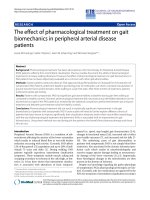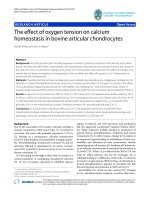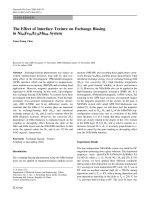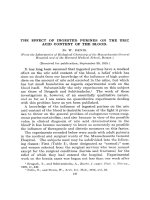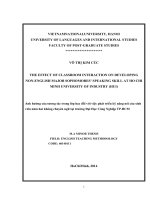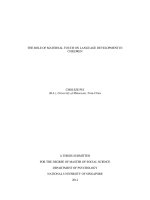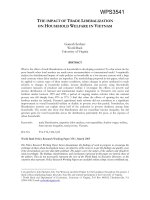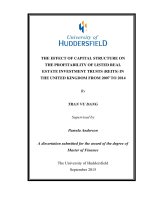The effect of households characteristics on education expenditure in vietnam
Bạn đang xem bản rút gọn của tài liệu. Xem và tải ngay bản đầy đủ của tài liệu tại đây (1.1 MB, 75 trang )
UNIVERSITY OF ECONOMICS
HO CHI MINH CITY
VIETNAM
INSTITUTE OF SOCIAL STUDIES
THE HAGUE
THE NETHERLANDS
VIETNAM - NETHERLANDS
PROGRAMME FOR M.A IN DEVELOPMENT ECONOMICS
THE EFFECTS OF HOUSEHOLD’S CHARACTERISTICS ON
EDUCATION EXPENDITURE IN VIETNAM
BY
HOÀNG HƯƠNG GIANG
MASTER OF ARTS IN DEVELOPMENT ECONOMICS
HO CHI MINH CITY, DECEMBER 2014
UNIVERSITY OF
ECONOMICS
HO CHI MINH CITY
VIETNAM
INSTITUTE OF SOCIAL
STUDIES
THE HAGUE
THE NETHERLANDS
VIETNAM - NETHERLANDS
PROGRAMME FOR M.A IN DEVELOPMENT ECONOMICS
THE EFFECTS OF HOUSEHOLD’S CHARACTERISTICS ON
EDUCATION EXPENDITURE IN VIETNAM
A thesis submitted in partial fulfilment of the requirements for the degree of
MASTER OF ARTS IN DEVELOPMENT ECONOMICS
BY
HOÀNG HƯƠNG GIANG
Academic Supervisor:
DR. TRẦN TIẾN KHAI
HO CHI MINH CITY, December 2014
DECLARATION
This is to certify that the thesis entitle “The effects of household’s characteristics on
education expenditure in Vietnam”, which is submitted by me in partial fulfillment
of the requirement for the degree of Master of Art in Development Economic to
Vietnam – The Netherlands Program. The thesis comprises only my original work
and due supervision and acknowledgement have been made in the text to all
materials used.
Hoàng Hương Giang
i|Page
ACKNOWLEDGEMENT
I would like to thank the great assistance of my supervisor, Dr Trần Tiến Khai, who
has given me valuable comment, important advices me to complete this thesis.
Besides, I sincerely thank all lectures in Vietnam – Netherlands Programme for
their dedicated instruction and all the courses during the study. In addition, I would
like to thank all the academic and technical staffs of the Vietnam – Netherlands
Programme for supporting during the course.
I also would like to thank my family, especially my mother and my husband, who
motive my effort and support me a lot to finish my study.
Finally, I would like to thank my classmates, Ms Linh and Mr Quang, who has
supported me to complete this work.
ii | P a g e
ABBREVIATION
GSO General Statistics Office
OLS: Ordinary Least Square
VHLSS: Vietnam Households Living Standard Survey
VND: Vietnam Dong
UNESCO: United Nations Educational, Scientific and Cultural Organization
iii | P a g e
ABSTRACT
Collecting 4636 observations at household level from VHLSS 2012, this study aims
to investigate the effects of current resources of family on education expenditure
ratio for children in Vietnam. The findings of the study provide the whole context of
the education expenditure situation in six regions of Vietnam as well as in urban
and rural. Besides, it is demonstrated that socio-economic status is the key
indicators to education expenditure ratio. Particularly, household’s income and
education level of household head positively effect on the ratio. Beside, the
occupation of household head is associated with education expenditure ratio for
children. In addition, the correlation between demographic factors and education
expenditure ratio is also analyzed. Accordingly, the findings indicate that education
expenditure ratio is associated with gender of household head. In fact, families
whose household head being mother have higher ratio than those whose household
head being father. Similarly, the education expenditure ratio of families being the
Kinh is also higher than those being other ethnic minority groups. Finally, the
correlation between higher education expenditure ratio with higher number of
schooling children confirms the fact that size of family is one the key factor
influencing on education achievement of children. Especially, the findings provide
that the education expenditure ratio for the boys and the girls are relatively equal in
Vietnam. Furthermore, the policy recommendations relating to education
expenditure were also drawn from findings to deal with the remaining
disadvantages.
Key words: current resources, education expenditure ratio, VHLSS 2012, socioeconomic, demographic factors, regions, policy.
iv | P a g e
TABLE CONTENTS
CHAPTER 1
INTRODUCTION
1.1 Problem Statements .................................................................................... 1
1.2 Research Objectives ................................................................................... 3
1.3 Research Question ...................................................................................... 3
1.3 Research Organization ................................................................................ 3
CHAPTER 2
LITERATURE REVIEWS
2.1 Definitions .................................................................................................. 5
2.1.1 Education definition ................................................................................ 5
2.1.2 Education expenditure ............................................................................. 6
2.2 Theoretical reviews..................................................................................... 7
2.2.1 Theory of Demand ................................................................................... 8
2.2.2 Human Capital Theory .......................................................................... 10
2.2.3 Integrated investment and consumption motives in a Neoclassical Model
of demand for education ........................................................................... 11
2.3Empirical studies ....................................................................................... 13
2.3.1 Effect of family backgrounds on education of children ...................... 14
2.3.1.1 Effect of Parental backgrounds on education of their children ....... 14
2.3.1.2 Effect of demographic factors on education of children ................. 16
2.3.1.3 Effect of geographic factors on education of children .................... 18
2.3.2 Empirical researches on determinant on education expenditure ......... 19
2.3.2.1 Determinant on education expenditure in rural India ......................... 19
2.3.2.2 Determinant on education expenditure in China ................................ 20
2.3.2.3 Determinant on education expenditure in United State ...................... 20
2.3.2.4 Determinant on education expenditure in Vietnam ............................ 21
2.4 Chapter summary ...................................................................................... 23
CHAPTER 3
DATA AND RESEARCH METHODOLOGY
3.1 Data descriptions ................................................................................... 24
3.1.1 Data Source ......................................................................................... 24
3.1.2 Data Descriptions ................................................................................ 24
3.2 Hypothesis .............................................................................................. 26
3.2.1 Socio – Economic Factors ................................................................... 26
3.2.2 Demographic factors............................................................................ 28
3.2.3 Geographical factors ............................................................................ 29
3.3 Method and Estimation Strategy ............................................................ 31
v|Page
3.3.1 Variables ............................................................................................. 31
3.3.1.1 The dependent variable ....................................................................... 31
3.3.1.2 The independent variables .................................................................. 31
3.3.2 Estimation strategy ................................................................................ 33
3.3.2.1Tobit setup ........................................................................................... 33
3.3.2.2Empirical model .................................................................................. 34
CHAPTER 4
EMPIRICAL RESULTS AND DISSCUSION
4.1 Education expenditure between regions of Vietnam ............................... 37
4.1.1 Expenditure ratio of education and of other goods ............................... 37
4.1.2 Education expenditure by education level of children .......................... 39
4.1.3 Education expenditure by gender of children ........................................ 41
4.1.4 Education expenditure in urban and rural areas .................................... 43
4.2 Education expenditure by parents’ backgrounds ...................................... 43
4.2.1 Education expenditure by education level of household head .............. 43
4.2.2 Education expenditure by household head’s occupation ...................... 45
4.2.3 Education expenditure ratio by gender of household head ................... 45
4.3 Tobit estimation ........................................................................................ 46
4.3.1 Estimation results and discussions ........................................................ 46
4.3.1.1 Effected by socio –economic factors .................................................. 48
4.3.1.2 Effected by demographic factors ........................................................ 49
4.3.1.3 Effected by geographic factors ........................................................... 50
4.3.2Testing for regression ............................................................................. 51
4.3.2.1Testing the significant of coefficients simultaneously for regressions51
4.3.2.2Heteroscedasticity test ......................................................................... 52
CHAPTER 5
CONCLUSION AND POLICY IMPLICATION
5.1Conclusion remarks ........................................................................................ 53
5.2Policy implications ......................................................................................... 54
5.3Limitation of the study and recommendation for future researches ............... 55
REFERENCES ................................................................................................... 57
vi | P a g e
APPENDIX
Appendix 1: Matrix of correlation between variables ........................................ 61
Appendix 2: Wald test of overall significance of the model .............................. 61
Appendix 3: Robust estimation of Tobit ............................................................. 62
Appendix 4: Tobit estimation result (schooling boy and schooling girl) ........... 62
Appendix 5: Tobit estimation result (schooling age ............................................ 63
Appendix 6: Tobit estimation result (boy and girl at schooling age) ................. 63
Appendix 7: Distribution of education expenditure ratio ................................... 64
Appendix 8: Average income by region ............................................................. 64
vii | P a g e
LIST OF TABLES
Table 3-1: The Observation proportion by regions ..............................................25
Table 3-2: Dummy variables ................................................................................26
Table 3-3: Schooling age and enrollment rate between regions ..........................30
Table 3-4: Statistical description of determinant household characteristics factors on
education expenditure ..........................................................................................36
Table 4-1(a): Expenditure ratio of education, Health care and Foods by regions38
Table 4-1 (b): T-test for mean of education expenditure ratio by regions ...........38
Table 4-2: Education expenditure ratio by primary, secondary, and high education
level by regions ....................................................................................................40
Table 4-3: Education expenditure ratio by gender of children ............................42
Table 4-4: Education expenditure ratio between urban and rural areas...............43
Table 4-5: Education expenditure ratio by education levels of household head. 44
Table 4-6: Education expenditure ratio by occupations of household head ........45
Table 4-7: Education expenditure ratio by gender of household head ................45
Table 4-8: Tobit Estimation Results ....................................................................47
Table 4-9: Effect of number of schooling age and of schooling children on
education expenditure ratio ..................................................................................50
Table 4-10: Wald test result on significance of the model ..................................51
Table 4-11: Tobit and Robust estimation of Tobit ...............................................52
viii | P a g e
LIST OF FIGURES
Figure 3-1: Schooling age and enrollment rate between regions .........................30
Figure 4-1: Expenditure ratio of education, Health care and Foods by regions ..39
Figure 4-2: Education expenditure ratio between regions by education level .....39
Figure 4-3: Education expenditure ratio by gender of children ...........................42
Figure 4-4: Ratio (a) and absolute value (b) of education expenditure by household
head education ......................................................................................................44
ix | P a g e
CHAPTER 1
INTRODUCTION
1.1.
Problem statements
The important of education has been acknowledged in both macro and micro side.
At macro side, Adam Smith (1776) proved that education is The Wealth of Nation.
Marshall (1890) asserted that education is also considered as the Principle of
economic. Schultz (1961) concluded that education is one of the key factors for
economic development of the nation. Meanwhile, at micro side, many of researches
proved the role of education in reducing unemployment rate, alleviating poverty.
Specifically, Singh (1992) and Van der Berg (2008) pointed out that person who
gets higher education level has greater opportunity of being employed, thus, can
earn more money. Besides, Rao & Datta (1989) proved that level of salary is
proportional with education level, means higher educational employees earn higher
salary. Therefore, education is one of the crucial factors which enhances income of
people and in general, leads the family to be out of poverty (Becker, 1993).
Schaafsma (1976) and Kodde & Ritzen (1984), however, demonstrated that
education decision for children may be constrained by the resources of family.
Specifically, household in developing countries, where has often had to self finance
for their children’ education, must be tradeoffs between education expenditure to
get future benefits of their offspring and other goods consumption to maximum
utility of the family (Glewwe & Jacoby, 2004; Qian & Smyth, 2008). Consequently,
how much to spend for education of children will depend on household budget
constraint and parents’ preferences for next generation achievement. Indeed,
economist have been evidenced that education decision for children is depended on
backgrounds of parents, including income and education level (Glick and Sahn,
2000), demographic factors (Poterba, 1996; Ray, 2000; Jæge, 2006), and geographic
factors of family (Ersado, 2005; Park, 2008; Jeynes, 2007).
1|P a g e
In Vietnam, education is always considered as the most important things of the
country. In fact, the Vietnamese put a very high value on education and households
incline to spent significant amount of resources on their children’s education
(Glewwe and Jacoby, 2000). There have been great studies dealing with education.
Most of them have focused on determinant return to education in Vietnam, such as
Moock & Patrinos(1998), Glewwe and Patrinos (1999), Moock, Patrinos, &
Venkataraman, (2003), Liu (2006), Nguyen.X.T (2006). Meanwhile, the role of
household characteristics to education of children, especially, to education
expenditure has not been documented in recent years. Although there are some
studies exploring this aspect of education but they have been conducted at
provincial level, such as Diep (2008) or Oanh (2012), not at national level.
Therefore, this study is developed in order to find out the effects of household
characteristics on education expenditure in the whole country of Vietnam. In
particular, the study concentrates on which the current resources of the family,
including socio-economic status of the family, demographic factors and of
geographic factors effect to education expenditure of children. These findings of the
study are to provide the whole context of up –to- date education expenditure
situation between regions of Vietnam and to explain how the change in socioeconomic status and in demographic structure of family effect to education
expenditure of children.
Besides, this research also differs from previous researches threefold. First is that
we exploit impact of households characteristics to education expenditure in spite of
to education attainment which has been predominantly used by other researches
(Behrman & Knowles, 1999; Tansel, 1997; Peraita & Sanchez, 1998; Glick and
Sahn, 2000; Maitra, 2003; Blanden and Gregg, 2004). Education attainment is not
only depended on the wealth of household but on the child’s capacity to study at
school (Qian and Smyth, 2008). Therefore, centering on education expenditure is
more advantage in term of reflecting financial capacities and backgrounds of family
to pay for education achievement of children than education attainment. Second
2|P a g e
contribution of the research is about the independent variables, which are divided
the into three groups, including socio-economic, demography and geography factor,
which have not been done before by other researches in case of Vietnam. Besides,
the study uses the number of schooling children variable rather than the number of
schooling age children which is often inputted by other researches (Huston, 1995;
Knight and Shi, 1996; Tilak, 2002). In fact, family having schooling age children
does not mean they will send that child to school. Consequently, it does not reflect
actual education expenditure spending for children. In other words, the number of
schooling age children variable may not be as good as the number of schooling
children variable in term of measuring the effect to education expenditure. Lastly,
this study conducts with VHLSS 2012, which is updated and large scale dataset
than previous studies.
1.2.
Research Objectives
The objective of this thesis is to identify the impact of household characteristic on
educational expenditure in Vietnam. In fact, it aims to point out that the families
who have more resource and better human capital able to spend more resource on
their children' education.
1.3.
Research question
The thesis aims to answer two questions:
-
What are the differences in education expenditure between regions of
Vietnam?
-
What and how do the socio-economic status, demographic factors and
geographic factors impact on education expenditure in Vietnam?
1.4.
Research Organization
This study consists five chapters. Next chapter reviews of theoretical and empirical
studies relevant to this study. Chapter 3 presents data analysis and methodology for
3|P a g e
estimation. The results are presented and interpreted in Chapter 4. Finally, Chapter
5 provides conclusions and limitations of the study.
4|P a g e
CHAPTER 2
LITERATURE REVIEWS
This chapter surveys the literatures on the education expenditure. It first introduces
some definitions relate to education. Second, it presents the theoretical researches
associating with education expenditure. Finally, it shows a review of empirical
studies on defining which factors impact on education expenditure for children.
2.1. Definitions
2.1.1 Education definition
Gillis et al (1992) asserted that education includes all channels through a person can
accumulate knowledge and skill in order to enhance his own human capital and
productivity. Accordingly, education is divided into three types, including formal
education, informal education and non –formal education.
Formal education refers to the procession of education and training conducted by
the educational institutions, including schools, colleges, universities, institutes and
educational centre.
Non-formal education is the procession of education conducted outside schools.
This kind of education is usually for the purpose of enhancing the knowledge or
skill for working by short time learning.
Informal education is the procession of learning that takes place neither school nor
organized program. People study by the things happened in the working place or
self-study at home.
In Vietnam, the Education Law 2005 asserts that “The national education system
consists of formal education and continuing education”. The Vietnamese
educational system comprises of Early Childhood Care and Education (ECCE),
general education, vocational education and high education.
5|P a g e
In particular, the Early Childhood Care and Education includes kindergartens,
starting at from 2 year old to 5 year old. General education constitutes three levels,
including primary with five grades, from grade 1 to grade 5, starting at 6 year old to
11 year old, lower secondary with fours grades, from grade 6 to grade 9, and upper
secondary with three grades, from grade 10 to grade 12. Vocational education has
three level elementary, intermediate and college level, conducting over 1 to 3 years
depending on the profession’s feature and requirement. High education consists of
college with 2-3 year course, undergraduate with 4-6 year course, master with 1-2
year course and doctorate level with 3-4 year course.
2.1.2 Education expenditure
Schultz (1961) proposed that education expenditure covers all cost arising from
studying procession. Accordingly, there are public expenditure and private
expenditure.
According to UNESCO’s definition, public education expenditure in education
means the expenditure made by the state or the government or public authorities.
Becker (1993) suggested that private education expenditure refers to the spending of
family for their children or the spending for education of themselves –studiers. This
kind of expenditure includes earning foregone and direct cost that spending of
education cost such as tuition, uniform, notebooks, books, etc.
Besides, Schaafsma (1976) asserted that at household level, education expenditure
has been conceived as investment decision and consumption decision. This decision
is not only depended on monetary benefits or return to education (investment side)
but also on the tradeoffs between spending for education to get monetary benefits in
future and spending for other goods to maximum utility of the family (consumption
side).
Specifically, Becker (1967) stated that in term of investment education expenditure
is kind of capital which invested by parents for their offspring. This case, parents
6|P a g e
hope that their children can earn more money when they graduate. That is the
factor, return to education, influence of schooling decision for children. There have
been many researches focusing on investment side of education. Accordingly, they
pointed out that on average, people with more schooling earn more than those with
less schooling (Schultz, 1961, Mincer, 1974; Rao & Datta, 1989; Psacharonoulos &
Ne, 1991; Ram, 1992; Geogre & Patrinos, 2004). These results support for the
belief of parent, as generally, which state that getting education is a way for their
children having a better live. Consequently, it can explain for the decision of parents
for education of children even thought education is not profitable for parents
(Kodde and Ritzen, 1984). In this circumstance, the schooling decision of parent for
children is viewed as consumption decision of family or as kind of obligation of
parents to children instead of investment decision (Glomm, 1997).
In term of consumption, education expenditure is presented the willing of parent to
reduce family expenditure on other goods in order to augment education level of
their children. Consequently, education decision must be constrained by the wealth
of family. As the matter of fact, this perspective has been examined by great studies
in many countries. These results demonstrated that how much spend for education is
depended on the endowment or characteristics of family (Huston, 1995; Glewwe&
Patrinos, 1999; Tilak, 2002; Qian & Smyth, 2008). The details of these studies are
presented in the empirical reviews section.
2.2 Theoretical reviews
In this section, theory of demand and theory of human capital are confronted to
explain for decision of education expenditure in accordance with consumption and
investment aspect. Then, it introduces the study that combines two theories to build
the model of integration of investment and consumption motive in demand for
education, which is used to build the empirical estimation model of this study in the
chapter 3.
7|P a g e
2.2.1 Theory of demand
At microeconomic side, education expenditure decision can be explained by
demand theory (Glomm, 1997).
According to Varian (1992), the basic hypothesis for demand theory is that
consumers want to have a most preference bundle of goods from the set of
affordable alternatives with two conditions:
First is to maximum utility function. Utility is the term expressed the satisfaction of
the consumer getting from a given goods consumption. The economist use utility
function which is presented by indifferent curve, which describes the combinations
of goods and service that get the same level of satisfaction.
Second is consumer’s budget constraint.
Supposed that m is the fixed amount of income available to a consumer and p =
(p1,…pk) is the vector of price of goods, 1,…,k. The budget of a consumer is depend
on the endowment A = (a1,…ak), the things that consumer can sold or can make the
money, m.
The set of affordable bundles, the budget of consumer, is given by:
B ={x in X: px<= m}
The problem of maximum utility function can be defined by:
Max u(x)
Such that px<=m
x is in X
Then, we can be rewritten two conditions above as:
v(x,m) =max u(x)
(2.1)
px =m
8|P a g e
The function v(x,m) defines the maximum utility achievable at given price p and
income m. The value of x solving this problem expresses how much of each good
the consumer desires at a given level of price and income. The demand function,
which relates p and m to the demanded bundle, can be written as: x(p,m), Marshall
demand function.
The (2.1) can be rewritten as:
Therefore, supposed, a family would like to spend for education (s) and other goods
(q) with the budget being m.
We have the conditions family has to satisfy is that
v(q,s,m) = max u (s,q)
q*p + s*pf=m
(2.3)
Where:
s: is time of schooling for education
pf: is full cost of education, including earning foregone or opportunity cost (w1)
and direct cost such as tuition fee, (ps).
p: is price of all other goods
q: is the vector of all other goods
From equation 2.3, we have the demand function for education is s(q, pf m) and can
be rewritten as
(2.4)
9|P a g e
Or
(2.5)
From the equation (2.5) we learn that decision of family for education expenditure,
as an consumption, will be depends on full cost of education including opportunity
cost (earning foregone, w1) and direct cost (tuition fee, book and notebook, other
related expense, Ps), and the endowment of family, the current resource of family.
2.2.2 Human capital theory
According to human capital theory (Becker, 1993), education expenditure is viewed
as an investment. For the investment, it is defined as the flow of resources into the
production of new capital.
In the case of education, resources are spent in the expectation that to produce
human capital. The expectation, therefore, is the rate of return to education. That is
the money people can get in future after schooling.
Supposed that an people who completes the secondary school resulting in earning
whose PV can be computed as
Where: PVW is sum of present value of all future benefit over an individual’s n
years of working. Wt is benefit of year t and I is the interest rate, which discounted
future benefits.
10 | P a g e
Where: PVC is sum of present value of anticipated private cost and Pf equal to the
opportunity cost, earning foregone while attaining school and plus direct cost paid
to school at year t. The internal rate of return (r) is determined as follows:
From the equation (2.8) we learn that as an investment, education expenditure, the
greater benefit and the lower cost, the higher is rate of return.
2.2.3 Integrating consumption and investment motives in a Neoclassical
Model of demand for education
In this section, we provide the theoretical model that we use for our empirical
specification. Based on the theory on investment side of education, human capital
theory and on the theory on consumption side of education, theory of demand,
Kodde and Ritzen (1984) made the combination between two aspects of education,
consumption and investment in a model.
Accordingly, first, the study exploited the consumption aspect of education and then
integrated in the human capital model.
In particular, the model divides time for a person into two periods. The first period
is the time for schooling, s, raises the future wage rate and the second period is
working time to earn money after graduating.
The relationship between schooling time, s, and the future wage rate in the second
period is presented by w2(s).
The full price of education (pf) in the first period includes earning foregone, w1, the
first-period wage rate, and education direct costs (tuition fees, book, notebook, and
related expenses), ps.
11 | P a g e
In accordant with the demand theory, the authors determined Marshallian demand
function for education of person as follows: SM (pf,p,m)
Where:
Pf is full cost of education, including earning foregone or opportunity cost (w1) and
direct cost such as tuition fee, (ps).
P is price of all other goods
m is budget or money available.
Then, similar to (2.3) that person wants to maximum utility of education with the
budget constraint as follows:
Whereas, fw = A +wT is the full wealth, in which, A is endowment and T is total
time of the person to schooling and earning money; w = (w1+ w2(s)) is total wage
rate of person can earn in time T. Therefore, (2.9) can be rewritten as
The Lagrangian for this problem is
The first –order condition are:
12 | P a g e
In the equation (2.13), W’2, is the marginal second –period discounted wage. And
from this equation, the study proves that on the one hand, if education expenditure
viewed as an investment, then Us =0, the equation 2.13 is become the human capital
model mentioned in equation (2.8). In particular, at the time T, the future discounted
wage equals to full cost of education. On the other hand, if education expenditure
viewed as an consumption, W’2(s) =0, the equation (2.12) and (2.13) are become the
demand function for education stated in equation (2.5).
Thus, the integrated investment and consumption motive of education demand is
defined from equation (2.12) and (2.13) as:
The equation 2.15 is the integrated consumption investment model, combining two
aspect of education expenditure. It helps to explain some empirical studies which
states that individual still demands for education even thought it is not profitable
(w1+sPs > W’2(s)T).
2.3 Empirical researches
This sector presents two kinds of empirical studies relating to education. First is
about the studies exploring the effect of family backgrounds on education of
children. Second is about the researches which focus on consumption side of
education expenditure.
13 | P a g e
2.3.1 Effect of family backgrounds on education of children
2.3.1.1 Effect of Parental backgrounds on education of their children
There are large of literature has focused on effect of parental backgrounds on
outcome of their children, including education. Among varies features of parents,
there are two factors that influence significant to education of children, parental
income and education.
Glick and Sahn (2000), basing on utility theory, using ordered and binary probit
models, investigated the effect of parental income and education on schooling of
boys and girls in a West Africa. Accordingly, they divide family’s life into two
periods. The first period is to work and support for their children. The second period
is to retire. In the first period, the household expenditure depends on current income
of the parents. There are two kinds of expenditure at that time, including
expenditure for children’s education or education investment and others
consumption for life. The education investment, in turn, decides the income of
household in future, the second period when parents retired. Therefore, parents have
to consider or have to trade off between two consumptions. The result found that
increasing in household income lead to the increasing on education attainment of
girl children but none effect on the boys. In addition, they also claimed that the
positive effect is not only on the attainment but also demonstrates grade attainment.
Besides, the study stated that education of parents have positively combination with
children schooling. In particular, the higher level of parents education is, the higher
attainment rate of children gets.
Similarly, Blanden and Gregg (2004) proves that income of family and education
attainment in United Kingdom has close relationship and this relationship has been
strengthening over time. They also claim that income does have a causal impact on
educational outcomes.
14 | P a g e

